|

URASENKE TRADITION OF TEA
After Sen Rikyu’s death in 1591, his heirs dispersed to
find refuge in the domains of daimyo lords who had studied under
Rikyu. Eventually Hideyoshi was persuaded by his generals Gamo
Ujisato and Tokugawa Ieyasu to restore the Sen household.
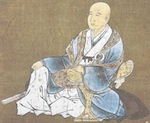 Rikyu’s
son-in-law, Sen Shoan Sojun (1546-1614), recognized as the inheritor
of the Sen tradition, re-established the Sen family in their current
location in Kyoto. Rikyu’s
son-in-law, Sen Shoan Sojun (1546-1614), recognized as the inheritor
of the Sen tradition, re-established the Sen family in their current
location in Kyoto.
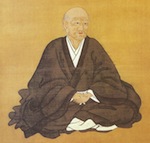 As Shoan’s son and Rikyu’s grandson,
Sen Sotan (1576-1658) succeeded his father to become third generation
head of the Sen household. Sotan adhered to the princples of wabi
both in tea practice and his life, eschewing appointment to the
ruling class and favoring unassuming utensils and tearooms. As Shoan’s son and Rikyu’s grandson,
Sen Sotan (1576-1658) succeeded his father to become third generation
head of the Sen household. Sotan adhered to the princples of wabi
both in tea practice and his life, eschewing appointment to the
ruling class and favoring unassuming utensils and tearooms.
Sotan had four sons. The elder two made their own
way in the world from an early age. When his youngest son Sen
Soshitsu (1622-1677) turned twenty years of age, Sotan retired
to the rear of the family property with him and endowed the third
son, Sen Sosa (1619-1673), with the Fushinan tearoom on the front
of the property.
Once Sotan transmitted the tea practice of his late
years to his youngest son, a new tradition of tea was born, led
by Soshitsu. This tradition became known as Urasenke, the back of
the Sen household, while that headed by Sosa was called Omotesenke,
the front of the Sen household. Later one of the older sons, Soshu
(1593-1675), returned to a property on Mushanokoji Street to establish
yet a third Sen tradition of tea named Mushanokojisenke.
The tearooms Sotan built on the rear of the Sen property
are a cherished legacy of the Urasenke Tradition of Tea. The eight-mat
Kanuntei, four-and-one-half mat Yuin, and one-and-three-quarter
mat Konnichian are viewed as setting the standard for wabi tearooms.
The Japanese government designated these tearooms Important Cultural
Properties.
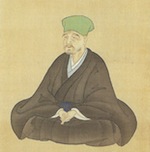 Rogetsuan
Senso Soshitsu, fourth generation head of the Urasenke Tradition,
collaborated with young craftsmen to produce a number of unique
utensils for tea. When Senso travelled to the Kaga domain to provide
tea instruction to the Maeda family, he was accompanied by an apprentice
from the Raku kiln and an apprentice from a well-known Kyoto kettle
maker. Today, the Ohi Chozaemon tradition of rakuware is active
in the tenth and eleventh generations while the Miyazaki Kanchi
tradition continues to make chanoyu kettles in the thirteenth generation. Rogetsuan
Senso Soshitsu, fourth generation head of the Urasenke Tradition,
collaborated with young craftsmen to produce a number of unique
utensils for tea. When Senso travelled to the Kaga domain to provide
tea instruction to the Maeda family, he was accompanied by an apprentice
from the Raku kiln and an apprentice from a well-known Kyoto kettle
maker. Today, the Ohi Chozaemon tradition of rakuware is active
in the tenth and eleventh generations while the Miyazaki Kanchi
tradition continues to make chanoyu kettles in the thirteenth generation.
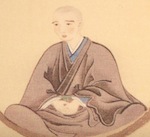 For
three generations—Fukyusai Joso (1673-1704), followed by his
son Rikkansai Taiso (1694-1726), and a son adopted from the Omotesenke
line Saisaisai Chikuso (1709-1733)
[portrait right]—the heirs to the Urasenke line all died young.
Still each one left calligraphic writings and tea utensil designs
that add depth to the world of tea. For
three generations—Fukyusai Joso (1673-1704), followed by his
son Rikkansai Taiso (1694-1726), and a son adopted from the Omotesenke
line Saisaisai Chikuso (1709-1733)
[portrait right]—the heirs to the Urasenke line all died young.
Still each one left calligraphic writings and tea utensil designs
that add depth to the world of tea.
The eighth generation head of Urasenke, Yugensai Itto
Soshitsu (1719-1771), also was adopted from the Omotesenke line.
He worked closely with his brother Joshinsai, the seventh generation
head of Omotesenke, advanced practitioner of tea Kawakami Fuhaku,
and a Daitokuji priest, Mugaku Soen, to formalize and thus revitalize
the traditions of chanoyu at a time when there was danger of them
slipping back into merely amusing pastimes.
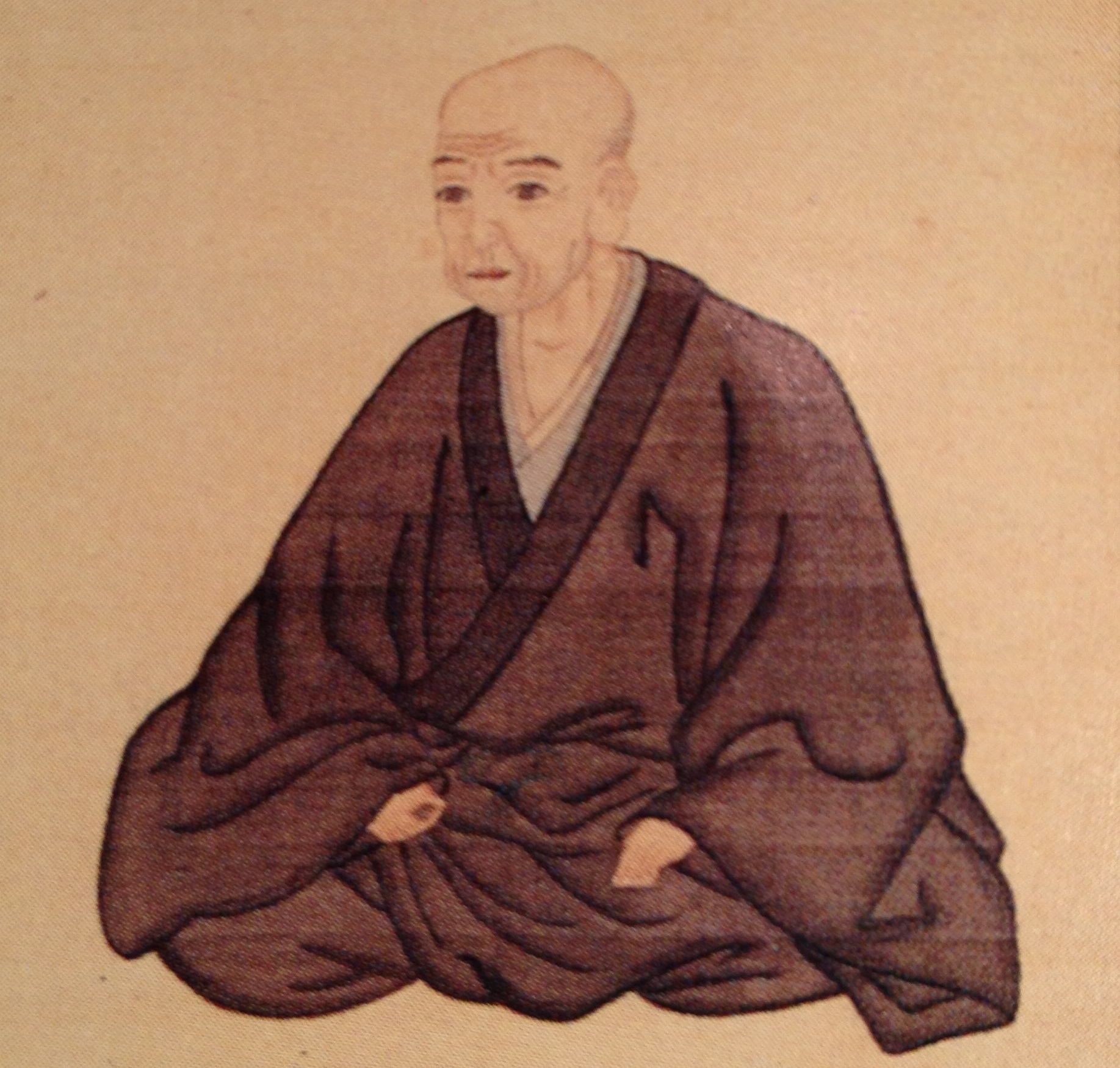 The
ninth and tenth generations Fukensai Sekio (1746-1801) and Nintokusai
Hakuso (1770-1826) [portrait right] put their efforts into
furthering Itto’s important work. However with the popularity
of daimyo tea and the taste for extravagance that developed in the
Tokugawa Period, it was a difficult task. The
ninth and tenth generations Fukensai Sekio (1746-1801) and Nintokusai
Hakuso (1770-1826) [portrait right] put their efforts into
furthering Itto’s important work. However with the popularity
of daimyo tea and the taste for extravagance that developed in the
Tokugawa Period, it was a difficult task.
 Gengensai
Seichu Soshitsu (1810-1877) was adopted into the Urasenke
family, marrying the daughter of Nintokusai and
becoming the eleventh generation master of the Urasenke Tradition.
He lived when the Meiji Restoration government, eager to modernize,
made a blanket classification of most traditional cultural practices
as frivolous and archaic attainments, a classification which endangered
their continuation. Gengensai wrote a letter, “Essential Ideas
in the Way of Tea,” which he sent to the Meiji Emperor. Concluding
with the poem, “Not in clothing, food, or shelter,/ Nor in
utensils or gardens -/ No excess of any kind,/ So that by sincere
practice/ The taste of tea shines through,” Gengensai’s
appeal won chanoyu, the Way of Tea, recognition as a true discipline. Gengensai
Seichu Soshitsu (1810-1877) was adopted into the Urasenke
family, marrying the daughter of Nintokusai and
becoming the eleventh generation master of the Urasenke Tradition.
He lived when the Meiji Restoration government, eager to modernize,
made a blanket classification of most traditional cultural practices
as frivolous and archaic attainments, a classification which endangered
their continuation. Gengensai wrote a letter, “Essential Ideas
in the Way of Tea,” which he sent to the Meiji Emperor. Concluding
with the poem, “Not in clothing, food, or shelter,/ Nor in
utensils or gardens -/ No excess of any kind,/ So that by sincere
practice/ The taste of tea shines through,” Gengensai’s
appeal won chanoyu, the Way of Tea, recognition as a true discipline.
Blessed with prolific creativity, Gengensai brought
forth numerous utensil designs as well as procedures for making
tea. One important innovation Gengensai wrought was in reaction
to the “opening” of Japan to the West. In 1872, for
the International Exposition, he devised a manner of serving tea
that used table and chairs so that Western visitors also would
feel comfortable. Today this ryurei, or “standing bow,”
style of tea remains extremely popular and is well suited for
presenting chanoyu in non-traditional environments.
 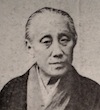 The
twelfth generation head of the Urasenke Tradition, Yumyosai Jikiso
(1853-1917), married Gengensai's daughter Shinseiin. She too was
very active in teaching the Urasenke tradition, and she was the
first to teach chanoyu in secondary schools. The
twelfth generation head of the Urasenke Tradition, Yumyosai Jikiso
(1853-1917), married Gengensai's daughter Shinseiin. She too was
very active in teaching the Urasenke tradition, and she was the
first to teach chanoyu in secondary schools.
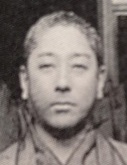 Their
son, Ennosai Tetchu (1872-1924), as the thirteenth generation forged
ahead to make the practice of tea more accessible to the public
at large. This included steps such as making the study of chanoyu
available within school curriculums and becoming the first tradition
of chanoyu to grant women licenses as teachers in the Way of Tea. Their
son, Ennosai Tetchu (1872-1924), as the thirteenth generation forged
ahead to make the practice of tea more accessible to the public
at large. This included steps such as making the study of chanoyu
available within school curriculums and becoming the first tradition
of chanoyu to grant women licenses as teachers in the Way of Tea.
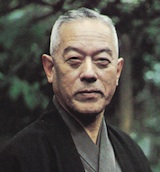 Tantansai
Mugensai Sekiso (1893-1964), fourteenth
generation, guided the Urasenke Tradition through the difficult
period of war. With the cessation of hostilities he opened his home
and tradition to the American forces in Japan and encouraged his
son Hounsai Genshitsu (b. 1923) to travel abroad to introduce chanoyu
to the West. Tantansai himself created the International Chado Cultural
Foundation in 1946 to assist in this task, and in 1962 he established
a full-time institution of higher education for the study of chanoyu. Tantansai
Mugensai Sekiso (1893-1964), fourteenth
generation, guided the Urasenke Tradition through the difficult
period of war. With the cessation of hostilities he opened his home
and tradition to the American forces in Japan and encouraged his
son Hounsai Genshitsu (b. 1923) to travel abroad to introduce chanoyu
to the West. Tantansai himself created the International Chado Cultural
Foundation in 1946 to assist in this task, and in 1962 he established
a full-time institution of higher education for the study of chanoyu.
Tantansai too had a prolific imagination when it came
to tea utensil design; his are embued with a deeply poetic quality.
Every morning, Tantansai and his wife Sen Kayoko wrote a waka poem
to begin the day. These poems were posted at the informal entrance
to Konnichian so that all coming and going could take a moment to
enjoy them.
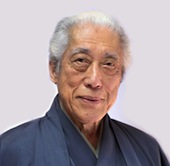 His son Hounsai Genshitsu (b. 1923), the fifteenth
generation, has devoted his life both to preserving the vitality
of traditions inherited from the past and to shepherding them
into the future. His scholasticism is well known through his many
publications; in English Tea Life Tea Mind,
Chado, Chanoyu, The Urasenke Tradition of Tea, and The Japanese
Way of Tea: From Its Origins in China to Sen Rikyu, as
is his internationalism. Hounsai Genshitsu incorporated into the
Urasenke Chado College a section known as Midorikai, for persons
from outside Japan to enter intensive study. His son Hounsai Genshitsu (b. 1923), the fifteenth
generation, has devoted his life both to preserving the vitality
of traditions inherited from the past and to shepherding them
into the future. His scholasticism is well known through his many
publications; in English Tea Life Tea Mind,
Chado, Chanoyu, The Urasenke Tradition of Tea, and The Japanese
Way of Tea: From Its Origins in China to Sen Rikyu, as
is his internationalism. Hounsai Genshitsu incorporated into the
Urasenke Chado College a section known as Midorikai, for persons
from outside Japan to enter intensive study.
 Zabosai
Genmoku Soshi Soshitsu XVI, son of Genshitsu, assumed leadership
of the Urasenke Tradition of Chanoyu in December 2002. Zabosai Iemoto
continues to be active in international cultural exchange, having
organized with his late brother Izumi Sosho a groundbreaking exhibition
titled “The New Way of Tea,” held at the Japan Society
and Asian Society galleries in New York City. Zabosai
Genmoku Soshi Soshitsu XVI, son of Genshitsu, assumed leadership
of the Urasenke Tradition of Chanoyu in December 2002. Zabosai Iemoto
continues to be active in international cultural exchange, having
organized with his late brother Izumi Sosho a groundbreaking exhibition
titled “The New Way of Tea,” held at the Japan Society
and Asian Society galleries in New York City.

|
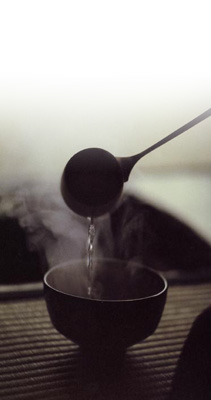
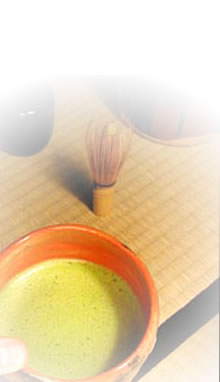
 Rikyu’s
son-in-law,
Rikyu’s
son-in-law,  As Shoan’s son and Rikyu’s grandson,
As Shoan’s son and Rikyu’s grandson,

 For
three generations—Fukyusai Joso (1673-1704), followed by his
son Rikkansai Taiso (1694-1726), and a son adopted from the Omotesenke
line
For
three generations—Fukyusai Joso (1673-1704), followed by his
son Rikkansai Taiso (1694-1726), and a son adopted from the Omotesenke
line  The
ninth and tenth generations Fukensai Sekio (1746-1801) and
The
ninth and tenth generations Fukensai Sekio (1746-1801) and 

 The
twelfth generation head of the Urasenke Tradition,
The
twelfth generation head of the Urasenke Tradition,  Their
son,
Their
son, 
 His son
His son 